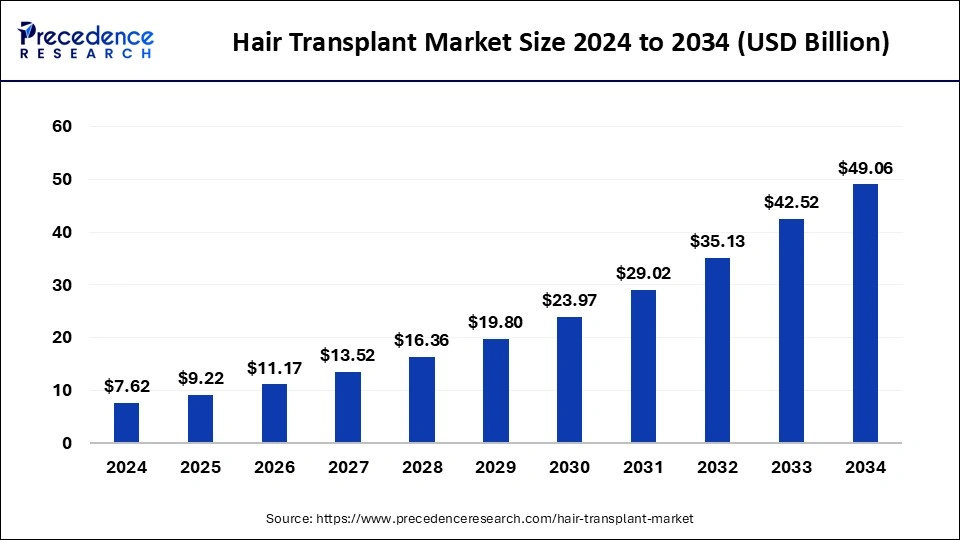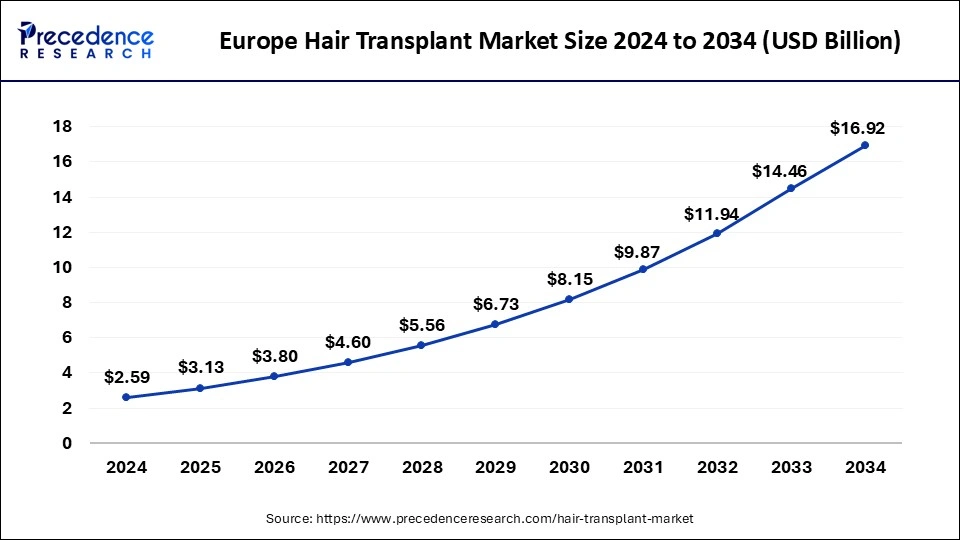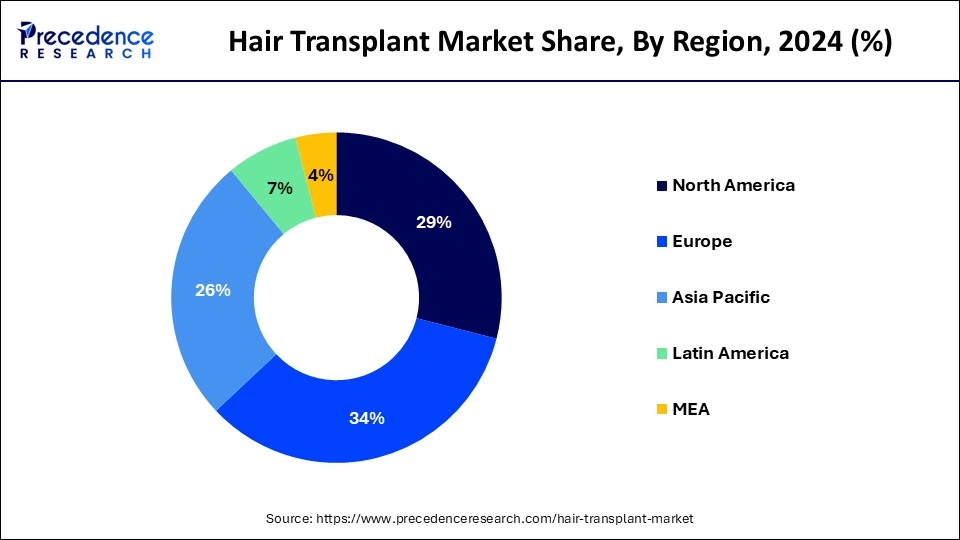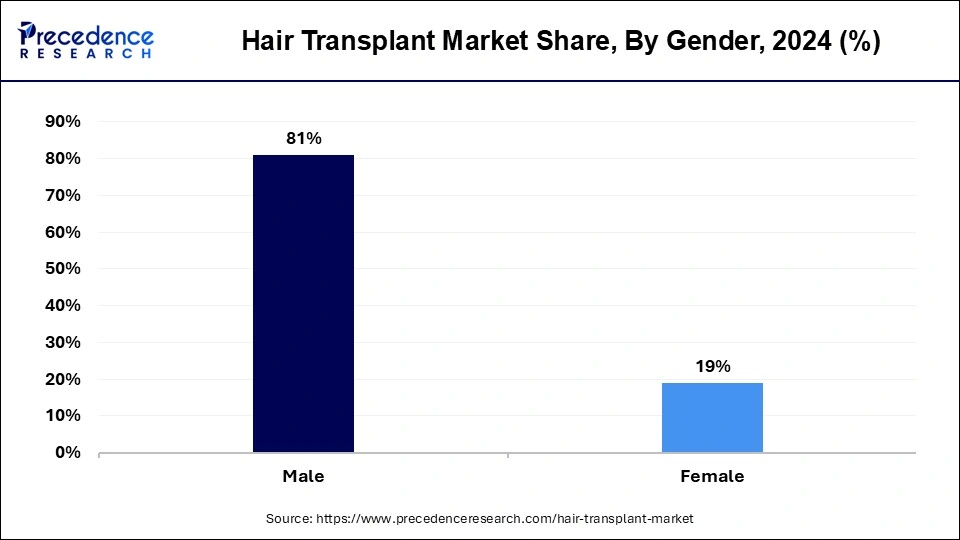February 2025
The global hair transplant market size accounted for USD 9.22 billion in 2025 and is forecasted to hit around USD 49.06 billion by 2034, representing a CAGR of 20.47% from 2025 to 2034. The Europe market size was estimated at USD 2.59 billion in 2024 and is expanding at a CAGR of 20.65% during the forecast period. The market sizing and forecasts are revenue-based (USD Million/Billion), with 2024 as the base year.
The global hair transplant market size accounted for USD 7.62 billion in 2024 and is predicted to increase from USD 9.22 billion in 2025 to approximately USD 49.06 billion by 2034, expanding at a CAGR of 20.47%.

The Europe hair transplant market size was exhibited at USD 2.59 billion in 2024 and is projected to be worth around USD 16.92 billion by 2034, growing at a CAGR of 20.65%.

Europe led the global market with the highest market share of 34% in 2024, leveraging its high-end medical infrastructures, renowned practitioners, and cutting-edge surgical technology. This combination of factors positions hair transplant procedures in Europe as a highly preferred choice globally. Hair transplant services in Europe offer a diverse range of advanced procedures, including Follicular Unit Transplantation (FUT), Follicular Unit Extraction (FUE), Direct Hair Implantation (DHI), and robotic hair transplant, tailored to individual specifications. These technological advancements not only enhance the precision of graft harvesting but also deliver aesthetic outcomes that seamlessly blend with non-transplanted hair, resulting in a natural-looking appearance.

Europe's well-developed transport network facilitates easy access to desired clinics for patients from around the world. Furthermore, the adoption of online consultation services enhances geographical accessibility, further solidifying Europe's position as the prime destination for hair transplant procedures. Beyond technical expertise, hair transplants in Europe are characterized by compassionate care that extends beyond the surgical table. With a focus on holistic patient care, Europe offers customized solutions that empower individuals undergoing hair transplantation, fostering a sense of dignity and confidence throughout the process.
Europe's leadership in hair transplant services epitomizes medical innovation, providing a comprehensive approach that encompasses both physical transformation and emotional well-being, making it a beacon of excellence in the global hair transplant market.
Hair transplant surgery is a specialized procedure aimed at restoring hair to areas of the scalp affected by baldness or thinning hair. Also known as hair restoration or hair replacement, it is typically sought by individuals who have exhausted other hair loss treatments. This surgical intervention is primarily performed by dermatologists, specialists in skin health, or plastic surgeons, experts in reconstructive procedures.
The surgery encompasses various techniques, including hair transplantation, flap surgery, tissue expansion of the scalp, and scalp reduction surgery. These methods can be employed individually or in combination to achieve optimal results in hair replacement. Each approach is tailored to the unique needs of the patient, ensuring the best possible outcome.
| Report Coverage | Details |
| Growth Rate from 2025 to 2034 | CAGR of 20.47% |
| Market Size in 2025 | USD 9.22 Billion |
| Market Size by 2034 | USD 49.06 Billion |
| Largest Market | Europe |
| Base Year | 2024 |
| Forecast Period | 2025 to 2034 |
| Segments Covered | Technique, Gender, and Service Provider |
| Regions Covered | North America, Europe, Asia-Pacific, Latin America, and Middle East & Africa |
Innovations in hair transplant techniques
The integration of robotic arms in hair transplant surgery represents a groundbreaking innovation driving significant growth in the market. With a continuous expansion of techniques, the latest advancements offer unparalleled precision and natural outcomes, aligning with the primary concerns of hair transplant surgeons. This technique enhances extraction precision and lowers associated risks, solely focusing on extraction while leaving implantation to skilled surgeons.
Leveraging stereo digital imaging maps and real-time monitoring, the robotic arm assesses follicular unit density and distribution, updating the status of each follicle 50 times a second. Furthermore, artificial intelligence sets the depth and alignment of follicular units, ensuring optimal results and stimulating further growth in the hair transplant market.
Growing demand among old age population
Hair transplant procedures have become increasingly commonplace, driven by their numerous benefits and high demand. The prevalence of hair transplantation has led to the establishment of numerous clinics offering these services. Despite the common occurrence of male-pattern baldness around the age of 60, age is not a limiting factor for individuals seeking hair transplant surgeries. Older men, ranging from 60 to 75 years of age, are not considered too old to undergo hair restoration treatment and can anticipate excellent results from their first-time procedures. This trend among older demographics contributes significantly to the growth of the hair transplant market as clinics cater to the increasing demand from this demographic segment.
High treatment cost
The hair transplant market faces restraint primarily due to the high cost of treatment and associated risks. The price of a hair transplant varies depending on the extent of hair movement, typically ranging from $4,000 to $15,000. However, this expense is often not covered by insurance plans, placing a financial burden on patients. Additionally, like any surgical procedure, hair transplants carry inherent risks such as bleeding, infection, scarring, and the possibility of unnatural-looking hair growth. Folliculitis, characterized by inflammation or infection of the hair follicles, can also occur during the early stages of new hair growth. While antibiotics and compresses can alleviate these issues, the perceived risks and costs associated with hair transplants serve as significant barriers, limiting the growth potential of the market.
Risk of potential complications
Despite being considered relatively safe with low risk; hair transplant surgery still carries inherent potential complications that pose a restraint on the growth of the market. While complications may range from minor complaints such as pain and itching to more serious surgical issues like infection, wound dehiscence, or skin necrosis, it's crucial to acknowledge the possibility of adverse outcomes in any medical procedure. Inadequate counseling and examination, as well as incomplete medical histories or allergies, can exacerbate the risk of complications during surgery.
Intraoperative complications, including anaphylactic shock, vasovagal shock, drug interactions, uncontrolled bleeding during strip harvesting, bronchospasm, or cardiac events, further underscore the need for thorough pre-operative assessment and risk mitigation strategies. These potential complications and risks associated with hair transplant surgery serve as significant restraints on the growth of the market, necessitating careful consideration and management to ensure patient safety and satisfaction.
Advancements in medical therapies
The ongoing research and innovation in newer medical therapies present a significant opportunity for growth within the hair transplant market. With a focus on newer injection stem cells and efforts to clone hair follicles, the aim is to regenerate hair without the need for traditional transplants and minimal donor follicles. Additionally, advancements in extraction techniques, such as vacuum-assisted devices, streamline the process and offer alternative solutions for patients.
Furthermore, ongoing upgrades to robotic devices enable automated extraction and implantation of grafts, reducing human involvement and potentially enhancing efficiency and precision. These developments not only expand the scope of hair restoration treatments but also create opportunities for innovation within the hair transplant market, catering to the evolving needs and preferences of patients seeking effective solutions for hair loss.
The follicular unit extraction (FUE) segment, in 2024 dominated the market. The segment plays a pivotal role in the hair transplant market, offering a sutureless method for hair restoration. In FUE procedures, hair follicles are extracted from the back of the head under local anesthesia using special micropunches and then implanted in the bald areas.
The FUE Matic machine represents an innovative advancement in automated hair transplant technology designed to assist doctors in performing FUE procedures more efficiently. This machine boasts a faster extraction rate of grafts within a limited timeframe, potentially increasing the overall efficiency of the procedure.
Overall, the introduction of the FUE Matic machine represents a significant technological advancement in the field of hair transplant surgery, offering both efficiency and convenience for practitioners and patients alike.
The male gender exerted significant influence within the hair transplant market, driven primarily by the prevalence of male pattern baldness or androgenic alopecia. Traditionally, hair transplants have been sought by men to address balding scalp areas, with the understanding that while transplants cover existing baldness, they do not prevent further hair loss. Recognized as a progressive condition, male pattern baldness often prompts consideration of combining surgery with medical treatments to slow down the balding process. What was once considered a sign of aging is now observed even among younger individuals, with hair loss occurring as early as one's twenties.

Male hair transplant procedures involve the minimally invasive surgical harvesting of follicular units from safe donor areas on the scalp or body hairs, followed by their precise transfer to the recipient or desired bald areas. These procedures require high precision and sensitivity, underscoring the importance of skilled hair transplant surgeons. Positioned as the most effective hair loss solution for men, hair transplants continue to be a sought-after option in the market, addressing both the physical and emotional aspects of male hair loss.
The clinics segment dominated the market with the largest share in 2024. In the hair transplant market, clinics play a pivotal role as service providers, offering a range of criteria to consider for prospective patients. Qualifications and experience of surgeons, alongside the availability of medical facilities in the operation theatre and post-operative care, stand as crucial factors. The clinic's infrastructure, including the behavior of staff towards clients and patients, and the demonstrated results of past cases, further shape patient decisions. Accessibility from main roads and parking availability also contribute to the value proposition of clinic venues.
For patients, a safe approach entails selecting healthcare providers with extensive experience, particularly in the realm of hair transplant procedures. Clinics are expected to maintain cutting-edge technologies in the medical field to ensure optimal patient outcomes. By aligning with clinics equipped with experienced professionals and the latest medical technologies, patients can confidently navigate their journey toward hair restoration. As such, clinics emerge as essential drivers in the hair transplant market, providing critical services that meet the diverse needs and expectations of patients.
By Technique
By Gender
By Service Provider
By Geography
For inquiries regarding discounts, bulk purchases, or customization requests, please contact us at sales@precedenceresearch.com
No cookie-cutter, only authentic analysis – take the 1st step to become a Precedence Research client
February 2025
August 2024